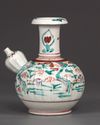A Japanese Kakiemon style porcelain kendi
Of typical form with a bulbous spout and faring neck ending in a everted rim, the body and spout ribbed and decorated with overglaze enamels showing four panels with a pagoda standing on the edge of a body of water.
A near identical Kendi can be found in the Princessehof museum identification number: GRV 1929-240
Kendi were widely used in Asia for the ceremonial drinking of water or taking medicine. From the 1660s, kendi were made in Japan for export mainly to Asia as they were not used in the domestic market. Many have been found in Indonesia, Thailand and as here Vietnam, but some were also exported to the Netherlands by the Dutch East India Company (VOC). In the Netherlands, kendi were more for interior decoration, sometimes used as vases. For more about kendi, see: Christiaan J.A. Jorg, Fine and Curious, Japanese Export Porcelain in Dutch Collections, (Amsterdam, 2003), p. 63-66; Oliver Impey, Japanese Export Porcelain – Catalogue of The Collection of The Ashmolean Museum Oxford, (Amsterdam, 2002), p. 183, no. 288. (Ashmolean Museum, Oxford); Ko-Imari Chosa Iinkai ed., Ko- Imari [Old Imari], (Kyoto, 1958), p. 211, no. 39 and 40.
Condition: minor restoration to the rim and spout, hairline to the base.




